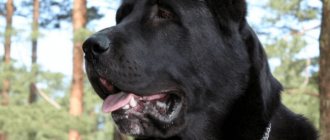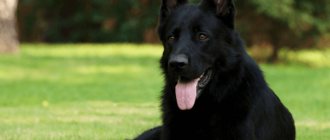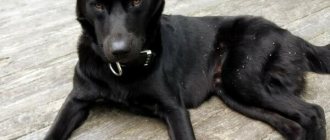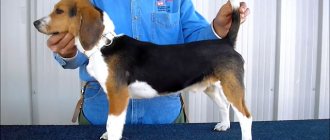Many families are looking to buy a German Shepherd.
After all, this is not only a guard, but also a companion.
She is good with children and trainable.
Incredibly smart and loyal.
This breed is also successful in service, because it easily manages to get used to new owners and a change of environment.
Thanks to this quality, it is almost indispensable in guard duty.
What is the breed standard
The German Shepherd Standard is a criterion established by the World Association of German Shepherd Owners and the Fédération Cynologique Internationale.
This is an officially recognized document for the examination of dogs of this breed in all countries of the world..
All standards are described for specialists. They contain a summary of the ideal characteristics of the breed, indicating possible faults and birth defects.
To correctly select a puppy and raise it, you need knowledge of individual articles, the causes of deficiencies and their impact on the general condition of the dog.
Expert opinion
Kozhevin Semyon Kirillovich
Expert dog handler.
“If you just walk in from the street and look at a puppy, you will hardly be able to distinguish a real German Shepherd from a similar mongrel. To see the differences and shortcomings at first glance, you need many years of experience, many years of studying the standard. Without it, it will be easy to fool you and sell you off to who knows who instead of a purebred puppy. So here you can only compare the points of the standard with the parameters and appearance of the dog that is offered to you.”
What it looks like according to RKF and FCI
- Size . The height at the withers for males is 60-65 cm, for females 55-60 cm. The body is 10-17% larger than the height of the dog.
- Weight. Males weigh 30-30 kg, and females - 22-32 kg.
- Head . German Shepherds have a wedge-shaped head, which is 40% of the height at the withers. Its general impression is dry and moderately wide. The head should be proportional to the body. The forehead is convex, but without a groove. The ratio of skull to muzzle is 50% to 50%, the width of the skull is the same as its length. It tapers from the ears to the nose when viewed from above and becomes wedge-shaped. The jaws are powerful and well developed. The lips are dark, dry, and fit tightly.
- Wool . German Shepherds should have a coat with an undercoat. Its cover should be dense and tough. The hair on the head, inside the ears and on the front of the legs, paws and toes is shorter than on the rest of the body. On the back side of the limbs the hair is elongated and can form fringes.
- Paws . The front legs, when viewed from the front, are parallel to each other. The elbows are also straight; they are not allowed to turn in or out. The feet are round, well built and collected. The pads are quite hard, the claws are strong and dark in color. The hind limbs are slightly left, but also parallel to each other. The thighs have good and strong muscles. The hind legs are the same as the front legs.
- Nose . The nose is straight, without humps. The nose should be black.
- Ears . The German Shepherd has medium-sized ears, set vertically, pointing upward, not hanging out to the sides. They have sharp ends and are positioned with the shell facing forward. Broken ears or soft ears are not allowed. The ears may lie back when moving or at rest. This is not considered a defect.
- Eyes . The dog has medium-sized eyes, they are almond-shaped, not protruding, but slightly oblique. The standard allows only dark eyes; dogs with light ones are disqualified, they violate the conformation of the breed.
- Neck . The neck is strong, with well-developed muscles; there should be no dewlap on the throat. The angle to the body should be approximately 45 degrees.
- Frame . The topline runs continuously from the base of the neck to the pronounced withers and falls in relation to the horizontal of the back to the sloping croup. The back of the German Shepherd is well developed - strong and strong.
- Croup _ The croup is sloping. It should be long and slightly falling. It smoothly transitions to the base of the tail.
- Tail . The tail is the size of the hock joint. On its underside the fur is longer. It is held in a gently hanging curve, but under tension it can rise, but not above the horizontal. Docked tails are not allowed.
Getting used to the swing
If you have a good grip, start teaching the swing: holding the roller by the handle with your left hand, swing with your right and stroke the dog from the muzzle to the skull. Repeat the exercise until the dog calmly responds to the swing, holding the roller in its teeth. Then change the exercise slightly: after the swing, pat the dog on the withers and sides.
Repeat the exercise until the dog begins to respond calmly to this action. When your pet gets used to swinging your hand, take a stick or a stick into it and do the same thing, only with the stick in your hand: swing the stick, stroke it with the hand with the stack. They swung it and patted it on the withers and sides with a hand with a stack clamped in it.
The next stage of learning defense is working with a grip and a soft sleeve. It is better that a professional person involved is already involved at this stage, since there are already a lot of nuances that you yourself may not feel and can harm your training.
Author of articles
Oksana Gromova
Practicing German Shepherd dog handler. 30 years of experience.
Working with a combat sleeve using a stack should definitely be taught by a professional, and not by a neighbor in a sweatshirt with a stick.
How does it move?
The German Shepherd is a trotting shepherd. The limbs are coordinated with each other in such a way that when moving, the animal can, without significant changes in the topline, move the hind limbs to the length of the body, just like the front ones.
The dog pushes off strongly with its hind legs, and at this time the front legs are carried beyond the border of the body to the same distance . The German Shepherd, which has a correctly built body, is slightly tilted forward when moving.
She moves easily and sweepingly. At the trot, when the head is bowed and the tail is raised, a continuous line of the back is visible from the tips of the ears to the tail.
Musculoskeletal system
The spine is the basis of the body; the rest of the dog’s proportions depend on its ratio.
With an exact correspondence of length and symmetry to height, the bones form an excellent motor system. There is a feeling of movement, devoid of tension. When running serenely, the dog's limbs move in a diagonal progression, forming a continuous line from the end of the tail to the end of the ears.
The heights are combined as follows: the front legs move the same distance as the hind legs, approximately to the middle of the body. Any shift in the hind paw reduces stability and strength.
Character traits
The German Shepherd has a balanced character. She has a stable nervous system, she is self-confident, sincere and friendly, if she is not in an excited state.
With all these qualities, she must be obedient, obey commands, easily remember them and train them.
Integral character traits of the animal are also loyalty, devotion, firmness, courage, well-developed fighting and service qualities. At the same time, the dog is an excellent companion, guard, protector and guard dog.
The German Shepherd treats children favorably and will never offend a child . She is distinguished by her instinct regarding the character of people, and is wary of ill-wishers.
Brief history of origin
The birthplace of the German Shepherd is Germany. Initially, representatives of the breed were used as a herding and service-search breed. However, these animals are now widespread throughout the world and perform many other functions.
The history of the German Shepherd breed dates back to 1899, when it was first presented at an exhibition. But the exact origin of the German Shepherd is unknown. According to the official version, it was bred on the basis of central and southern German herding dogs. Some experts believe that the blood of a wolf flows in her veins.
Color variations
The color of the German Shepherd is varied.
The coat can be black, gray, black and tan. Gray spots are allowed, but in small quantities. Combination with black is allowed, black mask on the face . In any case, the nose should remain black. A dog with white spots and white eyes may be rejected.
Also, the standard does not include completely white and red dogs.
White German Shepherds, like those with spots, are a defect - this indicates insufficient pigmentation in the body.
general description
Refined appearance, discipline, energy, neatness are exemplary traits of the breed. A breeding dog with an excellent sense of smell and absolute hearing, a stable central nervous system. Athletic and large build, slightly stretched, above average size.
The ratio of height and length is 9:10, respectively, height is less than length by about 10%.
Average height recorded by the standard:
- For males – 63 cm;
- For females – 56 cm.
A deviation of 2 centimeters is possible. Changes in different directions from the average height significantly reduce the pet's advantages.
The constitution of the body guarantees the feasibility of long running, and the coat protects from natural weather influences.
Sexual characteristics of cables and bitches are extremely pronounced. Clearly expressed, developed two testes near the cables are located in the scrotum.
Now let's look at the exterior of the German Shepherd, those predominant characteristics, the preservation of which is necessary when breeding pedigree breeds.
Read more in the article “Weight and height of the German Shepherd by month.”
Health and illness
Due to the correct body proportions, the German Shepherd is one of the breeds that is characterized by excellent and good health.
Their life expectancy ranges from 10 to 14 years .
However, there are diseases to which this breed is susceptible.
Therefore, it is important to recognize them in time and treat them:
- Hip dysplasia. This is an abnormal development of the hip joint that occurs as the dog matures and grows bones and joints. May cause hind leg failure;
- Epilepsy. This disease has no cure, but can be successfully suppressed with medications;
- Canine degenerative myelopathy. This disease is similar to human multiple sclerosis. Incurable;
- Anal furunculosis. The disease can be cured, but it tends to recur;
- Hemophilia. This is a blood clotting disorder. Only males are affected, but females are carriers;
- Pancreatic insufficiency. This is the most common disease in German Shepherds. They are doomed to take medication for the rest of their lives;
- Bloating and gastric volvulus. This disease is very dangerous. It occurs when a dog eats food quickly and then engages in physical activity. If you notice bloating in your dog, consult a doctor immediately, otherwise he may die in less than an hour.
Color
According to breed standards, the German Shepherd can be black in color with reddish-brown, brownish, yellow or light gray markings. The color can be monochromatic black and gray, but with a gray color with a darker coating. The undercoat is characterized by a light grayish tone, but white color is unacceptable. The color may have a black cloak and mask. The presence of inconspicuous small white markings in the chest area, as well as too light inner sides, is quite acceptable, but not desirable.
The nose of animals of any color should be exclusively black. Weakness of pigment may be represented by the absence of a mask, piercingly light eyes, and light to white markings on the chest or inner sides. Also, the weakness of the pigment is indicated by light claws and the presence of a red tip on the tail.
Return to content
Nutritional Features
When feeding your German Shepherd, you need to consider the ratio of proteins, fats and carbohydrates. Most of all should be meat, then come vegetables and grains, and only then vegetable or animal fats.
CAREFULLY!
German Shepherds should not be fed pasta, long bones, baked goods, flour, legumes, spices and canned foods.
You need to feed your dog twice a day at the same time. The food should not be too cold or hot, it should not contain excess liquid, and the meal itself should not last more than 20 minutes.
The best meats are turkey, beef, sometimes add lean pork . Beef bones and not tubular bones are also suitable, but they should be given when the dog is already full.
Buckwheat, oatmeal or rice are suitable cereals. It is allowed to give the dog raw or poached eggs several times a week.
Offal products are also suitable for feeding puppies . Calcined cottage cheese is also important for them.
Education and training
- Socialize your puppy. Dogs need to be exposed to people, places and other dogs when they are young. This will help them interact peacefully with everyone they come into contact with. If animals are not properly socialized during childhood, they may develop problems with aggression later in life.
- If your baby bites or jumps on you, you need to take immediate action. Otherwise, later it will become a habit, and you will not be able to control your pet.
- Start training your dog at about eight weeks of age. Although any German Shepherd is highly trainable, they are very strong and strong-willed animals. If you start training your friend early, you have the opportunity to shape his character at an early stage. Train your animal in stages: first teach easy commands, such as voice or place.
- German Shepherds are extremely intelligent and loyal dogs. This means that they quickly learn commands and obey their owners. However, it is important to train them in a positive manner. Praise the animals, pet them, and give them tasty treats for correct actions.
- Never hit or yell at your pet. Don't scold your dog unless you catch him doing something wrong. Otherwise, the animal will associate you with scolding, punishment and may lose trust in you. Let him know what behavior is unacceptable.
Lifespan
The German Shepherd lives 10-14 years. In rare cases, her life lasts longer. The longest age recorded for this breed is 20 years. Males live 1.5-2 years less than females.
The better you care for your dog , the longer it will live, the better its health will be .
Standards for a puppy
The standard of a puppy is primarily related to his mental and physical health, and not to your liking :
- The dog should look healthy and happy with life.
- Even at a young age, a puppy already has a scissor bite;
- At 3-4 months, puppies’ ears are not yet erect. If you see erect ends, this means that there is a lack of vitamins, phosphorus and calcium in the body;
- The color is already typical for the breed and similar to the parent;
- The puppy should be strongly built: compact bones, straight back, straight tail, slightly curved, but not curled over the back, round paws, not too short, but not too long muzzle;
- When running, the puppy should push off with its hind legs and throw out its front legs;
- The dog's temperament is adequate and resistant to change. The dog should be curious, but not aggressive.
- Puppy disadvantages include: light eyes and claws, feathering on the head and ears, malocclusion, crooked limbs, white and light color, aggression, cowardice and imbalance, wavy hair.
Wool
The rough hair on the head is shorter and softer to the touch than on the legs, toes, neck and back of the ears. On the hips it forms something like pants.
The coat of a real German comes in three types:
- normal coat;
- long-haired breeding dog;
- long-haired shepherd dog.
Disadvantages: Too thick, long coat is considered a fault. Especially on the tail.
How much does a purebred breed cost?
Depending on the class of the puppy, the price changes. But if we combine all three standards - pet class, breed class and show class, then the price range for a German shepherd varies from 10 thousand rubles to 650,000 thousand rubles.
NOTE!
The price depends on the region of purchase, the health of the dog, the availability of vaccinations and documents, pedigree, age, color, class, the place where you buy the puppy (kennel, breeder, private person), as well as on the title/non-title status of the parents.
Pros and cons of the breed
| Advantages | Flaws |
| High intelligence | Heavy shedding |
| Good learning ability | The need for constant physical and mental activity |
| Excellent watchdog and security qualities | Difficult to keep in an apartment |
| Child Compatible | Possible problems with the musculoskeletal system |
| No unreasonable aggression | – |
| Endurance | – |
| Beautiful appearance | – |
| Versatility | – |
The German Shepherd is a wonderful companion, guard and protector. But for a pet to become a true friend, it needs to be given a lot of attention, raised and trained correctly.
How to choose a dog?
To choose the right German Shepherd puppy, refer to the standard.
If the puppy looks as it should for its breed, and this was mentioned earlier, then look at its health and behavior:
- The mucous membranes should be pink and clean. There should be no discharge from the eyes and ears;
- A healthy puppy smells pleasant and there is no bad breath;
- The coat is soft, beautiful, without fleas and ticks. The skin under the fur should be free of wounds and scratches;
- Pay attention to how the puppy eats, wait until he goes to the toilet and look at the stool - the dog should not have worms;
- A healthy dog with a normal psyche is friendly, active, playful, and inquisitive. At the same time, he tries to please the person by listening to him;
- Play with the puppy and talk. His gaze should be meaningful and intelligent.
A bloated stomach can also indicate the presence of parasites in the body.
How much does a German Shepherd cost?
Potential show winners with impeccable breed standards and “champion” pedigree will not cost less than a thousand dollars.
They are usually sold at the age of 5-6 months, or even older - when external characteristics have already been formed and they even have experience of participating in junior “shows”. Purebred German Shepherd puppies, which do not qualify for international recognition due to certain formal shortcomings, but can become excellent service and guard or family dogs, are sold in kennels for prices ranging from 300 to 900 dollars.
Dogs without a pedigree are significantly cheaper, but in this case no one guarantees you either external or psychological compliance with the idea of a real German Shepherd.











